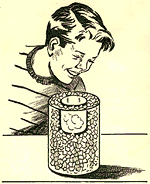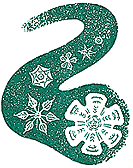


 This device is called a cold chamber. With a unit not differing greatly from this, scientists first experimented with "seeding" clouds to produce rain. You will need two cans, one very large (or a pail) and one smaller. Put some ice mixed with salt in the bottom of the larger can. Place the small can on the ice so that its top is level with the top of the larger can. Pack ice and salt in the space between the cans. The large can will grow very cold, so it is a good idea to wrap a towel around it to protect your hands. Soon the air in the small can will become very cold. When you breathe into the small can, the cold will condense the water vapor in your breath into a cloud.
This device is called a cold chamber. With a unit not differing greatly from this, scientists first experimented with "seeding" clouds to produce rain. You will need two cans, one very large (or a pail) and one smaller. Put some ice mixed with salt in the bottom of the larger can. Place the small can on the ice so that its top is level with the top of the larger can. Pack ice and salt in the space between the cans. The large can will grow very cold, so it is a good idea to wrap a towel around it to protect your hands. Soon the air in the small can will become very cold. When you breathe into the small can, the cold will condense the water vapor in your breath into a cloud.
 Snow will form in a cloud if it is very cold. Dr. Vincent Schaefer, shown here with a cold chamber at the General Electric Research Laboratories, discovered that if bits of dry ice, which is the solid form of carbon dioxide, were dropped into certain clouds that would normally be too warm to form snow, water vapor would freeze into tiny crystals. These crystals would grow, and eventually become snowflakes. Particles of silver iodide are also used for the same result.
Snow will form in a cloud if it is very cold. Dr. Vincent Schaefer, shown here with a cold chamber at the General Electric Research Laboratories, discovered that if bits of dry ice, which is the solid form of carbon dioxide, were dropped into certain clouds that would normally be too warm to form snow, water vapor would freeze into tiny crystals. These crystals would grow, and eventually become snowflakes. Particles of silver iodide are also used for the same result.
You can duplicate this by shaving off tiny bits of dry ice with a nail or small file into your cloud.  Be very careful not to touch the dry ice. It will cause severe freezing and serious damage. Once you scrape off a bit of dry ice into the cloud, shine a flashlight down into it. You should see many tiny sparkling crystals of ice. Gently breathe into the cloud to add moisture. Wait a minute or two, and breathe into it again. Eventually enough moisture will be added for the crystals to grow heavy enough to fall out of the cloud as very small snowflakes.
Be very careful not to touch the dry ice. It will cause severe freezing and serious damage. Once you scrape off a bit of dry ice into the cloud, shine a flashlight down into it. You should see many tiny sparkling crystals of ice. Gently breathe into the cloud to add moisture. Wait a minute or two, and breathe into it again. Eventually enough moisture will be added for the crystals to grow heavy enough to fall out of the cloud as very small snowflakes.

This article was printed from the Bizarre Labs website at bizarrelabs.com